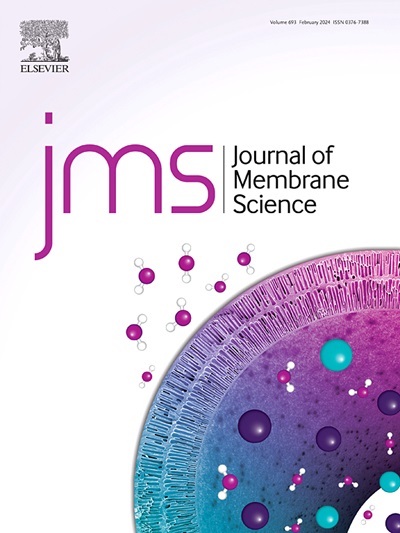同轴纳米纤维的微观结构有利于质子交换膜的连续传导和增强,降低了钠离子的含量
IF 8.4
1区 工程技术
Q1 ENGINEERING, CHEMICAL
引用次数: 0
摘要
质子交换膜具有高导电性、低溶胀性和低成本等优点,是其在燃料电池中应用的研究热点。在这项研究中,独特的同轴纳米纤维微观结构划分了导电Nafion和增强聚偏氟乙烯(PVDF)组分的壳层和核心功能层,以优化膜的导电增强性能。PVDF纤维形成芯拖着Nafion形成壳层,解决了Nafion全氟磺酸聚合物可纺性的限制。壳层中高达100%的Nafion微相增强了质子传导通道的连续性,核心层中高达100%的PVDF微相增强了膜的稳定性。PVDF芯层使同轴纳米纤维膜在80℃下具有极低的溶胀率,仅为1.5%。同轴纳米纤维微结构确保了壳层中100%的Nafion连续性,将Nafion的总含量降低到77.5 wt %,但将质子电导率提高到241.9 mS cm - 1,在80°C时燃料电池的峰值功率密度为1119.3 mW/cm2,分别比Nafion 211提高了19.6%和27%。同轴功能分区设计为高性能质子交换膜提供了优化的微观结构。本文章由计算机程序翻译,如有差异,请以英文原文为准。

The coaxial nanofiber microstructure facilitates continuous conduction and reinforce in proton exchange membranes with reduced Nafion content
Proton exchange membranes with high proton conductivity, reducing swelling and cost are the research focusses in their application for fuel cells. In this study, the unique coaxial nanofiber microstructure divides shell and core functional layers for the conductive Nafion and reinforcing poly(vinylidene fluoride) (PVDF) components, respectively to optimize conduction-reinforce properties of the membrane. The PVDF fiber-forming core drags Nafion to form the shell layer, addressing the spinnable limitations of Nafion perfluorosulfonic acid polymer. Up to 100 wt% of Nafion microphase in the shell layer enhances continuity of proton conducting channels, and up to 100 wt% PVDF microphase in the core layer reinforces the membrane. PVDF core layer endows coaxial nanofiber membrane with extremely low swelling ratio of 1.5 % at 80 °C. The coaxial nanofiber microstructure ensures 100 % Nafion continuity in the shell layer, reducing overall Nafion content to 77.5 wt % but increasing proton conductivity to 241.9 mS cm−1 and fuel cell peak power density of 1119.3 mW/cm2 at 80 °C, 19.6 % and 27 % improvements, respectively over Nafion 211. The coaxial functional zoning design-offers an optimized microstructure for high-performance proton exchange membranes.
求助全文
通过发布文献求助,成功后即可免费获取论文全文。
去求助
来源期刊

Journal of Membrane Science
工程技术-高分子科学
CiteScore
17.10
自引率
17.90%
发文量
1031
审稿时长
2.5 months
期刊介绍:
The Journal of Membrane Science is a publication that focuses on membrane systems and is aimed at academic and industrial chemists, chemical engineers, materials scientists, and membranologists. It publishes original research and reviews on various aspects of membrane transport, membrane formation/structure, fouling, module/process design, and processes/applications. The journal primarily focuses on the structure, function, and performance of non-biological membranes but also includes papers that relate to biological membranes. The Journal of Membrane Science publishes Full Text Papers, State-of-the-Art Reviews, Letters to the Editor, and Perspectives.
 求助内容:
求助内容: 应助结果提醒方式:
应助结果提醒方式:


